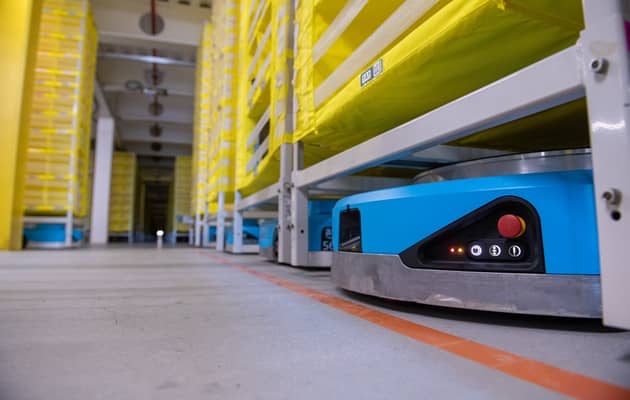Imagine walking into a warehouse where the air is stale, the temperature fluctuates wildly, and condensation drips from the ceiling. Now imagine storing millions of dollars worth of inventory in that environment. It’s not just uncomfortable—it’s a business disaster waiting to happen.
In today’s fast-paced logistics landscape, environmental control systems have evolved from luxury features to absolute necessities. They’re the unsung heroes that protect your assets, ensure regulatory compliance, and maintain operational efficiency. Learn more about why these systems are mission-critical for any modern warehouse or distribution center below. Read on.
1. Comprehensive inventory protection: Beyond basic temperature control
Your inventory represents your company’s lifeblood, and environmental factors can degrade it in ways you might not expect.
Luckily, a custom environmental control unit helps preserve perishable goods as well as address vulnerabilities of non-perishable items.
For starters, food products require precise temperature bands to prevent bacterial growth. Aside from that, pharmaceuticals may need accurate temperatures to maintain efficacy. Finally, flowers and plants often need specialised humidity-controlled zones. The answer to those concerns? Environmental control systems.
Aside from perishable goods, non-perishables also face vulnerabilities. Examples include the following: paper products warp and discolor in humid conditions, textiles develop mildew when moisture exceeds a certain level, and electronics suffer ‘tin whisker’ growth in certain temperature cycles. Happily, environmental control systems can address those.
2. Advanced equipment longevity strategies
Modern warehouses increasingly rely on sophisticated automation, making climate control more crucial than ever.
Robotics and automation systems
Modern technology paved the way for the rise of robots and other automation systems. Nonetheless, they have different requirements: industrial robots typically require low-temperature operating environments, lithium-ion batteries degrade faster in high temperatures, and optical sensors malfunction with dust accumulation.
Conveyor system considerations
Modern conveyors need to operate under specific environments. Rubber components dry out and crack in low humidity. Aside from that, metal parts experience accelerated corrosion in salty air environments. Lastly, bearings require specific lubrication viscosity based on temperature.
How environmental control systems help
Environmental control systems offer the following benefits to equipment: proper conditions can double the lifespan of electric motors, ventilation systems themselves last longer when not overworked, and reduced downtime translates to higher throughput capacity.
3. Workforce optimisation: The human factor
The link between environmental conditions and labor productivity is well-accepted.
Thermal comfort is a must for maximum productivity (it’s been said that productivity levels drop when workplace temperature rises). Aside from that, cognitive function declines in poorly ventilated spaces.
The air quality is a determining factor for a comfortable environment as well. Air quality innovations ensure less drowsiness, fewer viruses and ultrafine particles in the air, and so on. Alongside that are specific air quality standards set by authorities.
Make sure that you take care of your team and their welfare by using environmental control systems. You’ll be able to have comfortable workplaces that have lower turnover rates, onboard younger workers who prioritise healthy work environments, and many more.
4. Regulatory landscape: Staying ahead of compliance
The regulatory environment is becoming increasingly stringent. Standards are continuously evolving which involve pharmaceutical storage, requirements for food logistics, and guidelines for medical products.
Aside from standards, certification requirements are getting more and more complicated. Those include cleanroom standards, good storage practices, food safety audits, and many more that are being asked from warehouses.
Luckily, environmental control systems can be helpful. Aside from the regulatory and compliance side, they can aid with liability protection. How? Documented environmental controls provide legal defense, automated logging satisfies audit requirements, and what not.
Frank Hoermann / SVEN SIMON / DPA Picture Alliance / Avalon
5. Energy efficiency: Smart systems for sustainable operations
Modern environmental control goes beyond the basics, they perform using only the most efficient energy means to deliver results.
Cutting-edge technologies in environmental control that are planet-friendly as well include the following: variable refrigerant flow (VRF) systems, thermal energy storage solutions, and artificial intelligence (AI)-powered predictive climate adjustment.
Renewable integrations are coming to dawn as well. They range from solar-assisted temperature control and geothermal heat exchange applications to waste heat recovery systems.
How about the return on investment (ROI)? Typical payback periods of three years, utility rebates for high-efficiency installations, and many more.
6. Specialised applications: Meeting unique needs
Some sectors demand extraordinary solutions.
For instance, hazardous material storage requires explosion-proof climate systems, negative pressure environments, and chemical filtration requirements. On the other hand, high-value goods need specific environmental requirements. Fine art storage needs specific temperatures, environment controls are a must for data servers, and so on. All of those can be addressed with environmental control systems.
Aside from that, today’s e-commerce warehousing asks a more stringent climate control. Solutions include multi-climate zones in mega-fulfillment centers, robotics-friendly environmental design, and rapid temperature recovery after dock door openings.
7. Future-proofing your facility: The next generation
Emerging trends demand forward-thinking solutions; environmental control systems help you and your facility keep up with the changing times.
Climate change resilience tops the list. This includes preparing for more extreme weather events, flood prevention systems, and wildfire smoke mitigation.
Next, technology integrations like the following are invaluable: Internet of Things (IoT) sensor networks for microclimate monitoring, blockchain-enabled condition tracking, and digital twin simulations for system optimisation.
Finally, in times of pandemics and other pan-regional health outbreaks, preparation is key. Antimicrobial surface treatments, air sterilisation, and contactless climate controls must always be ready.
Luckily, all of those are addressed with environmental control systems.
Implementation roadmap: Your path to optimal control
Want a successful implementation of environmental control systems in your facilities? Take into account the following phases for guidance:
Phase 1: Assessment
The first step is assessment. This includes thermal imaging surveys, airflow pattern analysis, energy audits, and other tests that need to be carried out in your warehouse facility.
Phase 2: System design
After the assessment, you’ll undergo the system design phase. This includes the following: zoning strategy development, equipment selection, and redundancy planning. All of those are crucial for efficient and effective environmental control systems adaption in your warehouse.
Phase 3: Installation
Now comes the most important part: the installation of the system. First, proceed with phased implementation to prevent disruptions. Next, staff training is implemented to ensure everybody’s on board. Finally, baseline testing is done before proceeding to a full implementation.
Phase 4: Optimisation
It’s not over once the installation phase is completed. Continuous monitoring, seasonal adjustments, and predictive maintenance are all a must to ensure optimisation and efficiency along the road.
Final words
In an era where supply chain resilience makes or breaks businesses, environmental control systems have become the differentiator between industry leaders and struggling operations. They’re no longer about mere compliance—they’re about gaining strategic advantage.
The most successful logistics operators aren’t just installing basic climate control—they’re implementing intelligent environmental ecosystems that actively contribute to business success.
Your next step? Partner with specialists who understand both the engineering and the economics of warehouse environmental systems. Because in today’s market, controlled environments aren’t an expense—they’re one of the smartest investments you can make.








